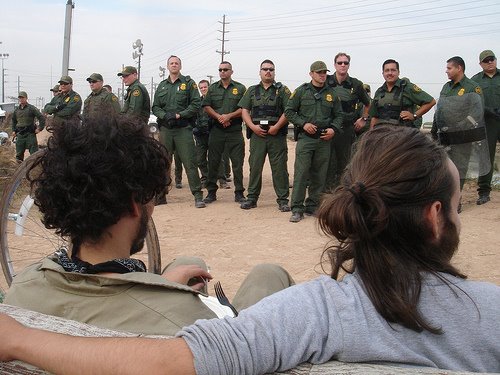January/February 2009 Dollars & Sense magazine
The terrorist attacks of Sept. 11 drastically altered the traditional
political economy of immigration. The millions of undocumented immigrants—those
who crossed the border illegally or overstayed their visas—who were living and
working in the United States were no longer simply regarded as a shadow
population or as surplus cheap labor. In the public and policy debate,
immigrants were increasingly defined as threats to the nation’s security.
Categorizing immigrants as national security threats gave the government’s
flailing immigration law-enforcement and border- control operations a new
unifying logic that has propelled the immigrant crackdown forward. [...]
Rather than addressing immigration as the complex socioeconomic issue that
it is, Homeland Security has reduced immigration policy to a system of crime and
punishment. Applying the simplistic law-and-order logic propagated by
restrictionists, DHS regards undocumented immigrants not as workers, community
members, and parents but as criminals. [...]
In the prison industry, bed is a euphemism for a place behind bars. Even
President Bush talked the prison-bed language when discussing immigration
policy. When visiting the Rio Grande Valley in south Texas in 2006 to promote
the immigrant crackdown, the president said: “Beds are our number one
priority.”
The number of beds for detained immigrants in DHS centers has increased
by more than a third since 2002. There are now 32,000 beds available for the
revolving population of immigrants on the path to deportation, and another 1,000
are scheduled to come on line in 2009. This doesn’t include beds for immigrants
in Homeland Security custody that are provided by county, state, and the federal
Bureau of Prisons.
At the insistence of such immigration restrictionists as Rep. Tom
Tancredo (R-Colo.), the Intelligence Reform and Terrorism Prevention Act of 2004
contained an authorization for an additional 40,000 beds to accommodate
immigrants under U.S. government custody.
At the onset of the immigration
crackdown two years ago, ICE dubbed its promise to find a detention center or
prison bed for all arrested immigrants “Operation Reservation Guaranteed.” The
Justice Department has a similar initiative to ensure that the U.S. Marshals
Service has beds available for detainees—about 180,000 a year, of whom more than
30% are held on immigration charges. [...]
READ MORE: http://www.dollarsandsense.org/archives/2009/0109barry.html
